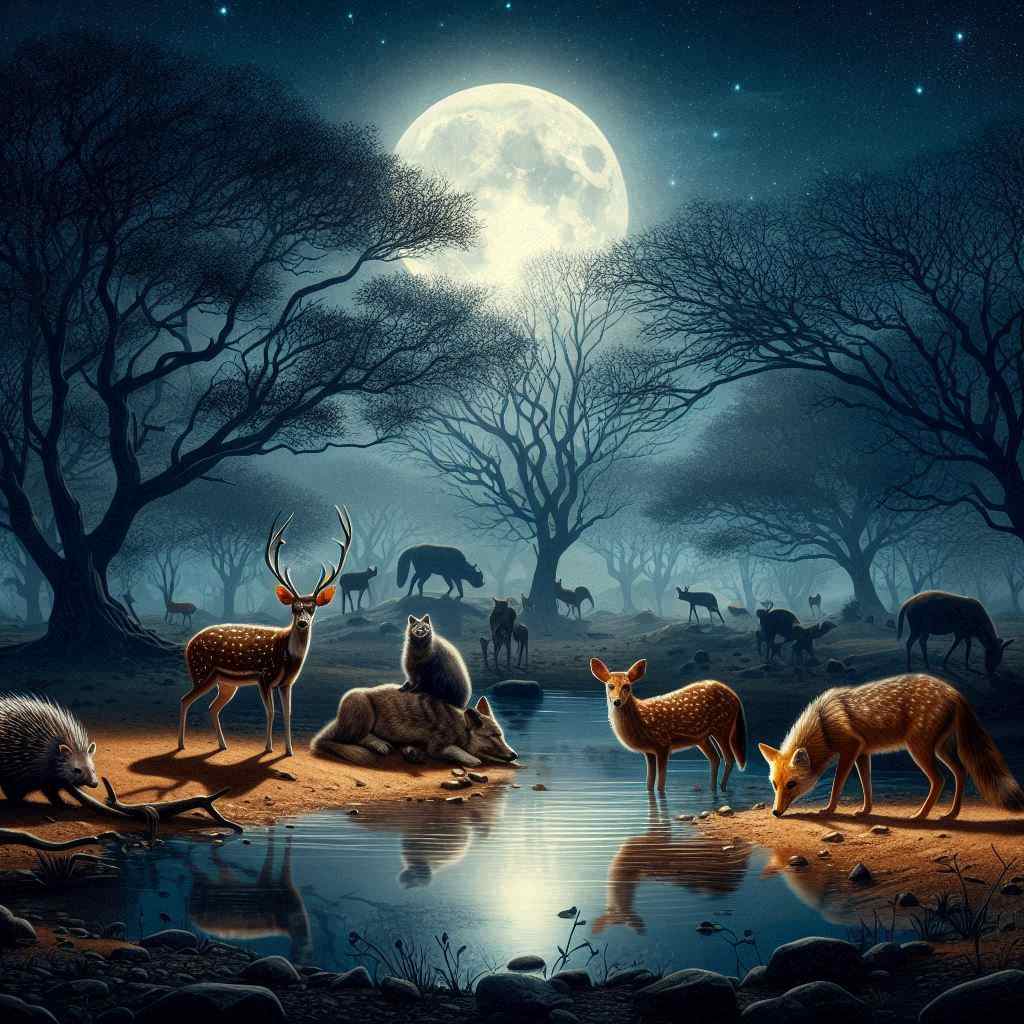The world is a beautiful place, and animals constitute a significant part of this world. Nocturnal animals are found abundantly in the world, and they are an amazing gift of Mother Nature. Nocturnal essentially means animals hunt at night for food and rest when the sun is up.
India is home to a fascinating array of nocturnal animals, adapted to thrive in the darkness of night. These creatures have evolved specialized features to navigate their environment during nighttime hours.
Let us check out some of the many amazing nocturnal animals that can be found in India!
Eyelash Viper

This is a nocturnal snake that is very venomous, too. However, they can be considered one of the most beautiful-looking snakes because they are found in different colors, like red, yellow, brown, and green.
Mouse

The mouse has poor eyesight, and they are super active at night. They use their sense of smell and hearing to locate food at night. In fact, hamsters are also nocturnal animals because they belong to the same family as the mouse. So, you must actually play with your hamster at night and let them relax during the day.
Raccoon

Raccoons are another one of those nocturnal animals that are very popular in India. You will definitely adore these animals because they are expert robbers. They have fantastic night vision and, hence, can steal things without anyone knowing about it. Also, just like humans, they are omnivores and eat almost anything.
Scorpions

Scorpions usually appear at night, and they are hiding inside comfortable holes during the day. You will seldom find a scorpion moving around during the day. The primary reason for this is that they are very nocturnal. Their venomous sting is potent, but they play a crucial role in controlling insect populations.
Bat

Bats are one of the first animals that come to mind when we think about nocturnal animals. These large fruit bats are impressive fliers, often seen gliding through the night sky. They feed on fruits, nectar, and flowers, contributing to seed dispersal and pollination.
They have excellent night vision and come to life during the night. They are also pretty endemic to India and are found in abundance in the country.
Cat

To everybody’s surprise, cats are nocturnal too! Wildcats are known to do their hunting at night, and they usually rest during the day. It is true for domesticated cats too. However, lifestyle change modifies their behavior. If you notice your house cat, they will usually be lazy and try to sleep during the day and become active as everyone starts to fall asleep at night and the house becomes silent. So, yes! Your cats are primarily nocturnal.
Cockroaches

Cockroaches are other nocturnal animals that are found abundantly in homes. They have really poor eyesight but can still somehow tell when it is day and when it is night. Cockroaches usually rest during the day and eat stolen food at night.
Owls

Known for their heart-shaped faces, barn owls are skilled hunters. Their silent flight allows them to surprise prey like rodents and small birds. They nest in tree hollows or abandoned buildings. Owls are totally adapted for the nightlife. Their eyes have wide eyes that are disproportional if you compare it to their skull. It helps them see better at night.
Fireflies

Fireflies are absolutely nocturnal, and they look beautiful at night. Therefore, you don’t see them often during the day. They are stunning creatures with green, pale red or yellow color reflecting from their abdomen. This light is reflected in the special enzymes that create a special chemical reaction. This reflection happens as a result of bioluminescence, and you can see this phenomenon in fireflies even in a period when they are larvae.
Hamsters

You might have hamsters at home and love playing with them all day long. But they belong to the mouse and rat family, so they are very nocturnal. You will not come across wild hamsters during the day because they hide from their predators in the ground. They also have poor eyesight, but a great sense of smell helps them compensate it.
Some more nocturnal animals are here:
Nightjar Birds: These cryptic birds are masters of camouflage. Their mottled plumage blends seamlessly with tree bark or leaf litter. Nightjars are insectivorous and hunt insects on their wings during the night.
The Indian Krait Snake (Bungarus caeruleus) is a venomous and nocturnal krait. Its striking black-and-white bands serve as a warning to potential predators. It preys on other snakes, frogs, and rodents.
Tarantula Spider: India is home to several tarantula species. These large, hairy spiders are primarily nocturnal. They live in burrows and ambush insects that wander too close.
Binturong (Arctictis binturong), also known as the bearcat, is a tree-dwelling mammal. It has a prehensile tail and feeds on fruits, leaves, and small animals. It bears no resemblance to bears or cats, despite its name.
Indian Leopard (Panthera pardus fusca): Leopards are solitary and elusive big cats. They are powerful swimmers and tree climbers. Their nocturnal habits help them avoid human encounters and maximize hunting success.
Sloth bears (Melursus ursinus) are primarily nocturnal and feed on fruits, ants, and termites. They are the most widespread bear species in India.
Indian Striped Hyena (Hyaena hyaena): These scavengers are active at night, scavenging on the remains of other animals’ kills. They play a vital role in maintaining ecosystem balance.
Some Frequently Asked Questions About Nocturnal Animals
What defines a nocturnal animal?
Nocturnal animals are active during the night and rest during the day. They have adapted to the dark through various evolutionary traits, such as enhanced night vision, acute hearing, and a strong sense of smell.
Why are some animals nocturnal?
Many animals are nocturnal to avoid the heat of the day, especially in hot climates like India’s. Others may be nocturnal to evade predators or to take advantage of prey that is more active at night.
Can you name some nocturnal animals found in India?
India is home to a variety of nocturnal animals, including the Indian Flying Fox, Barn Owl, Nightjar birds, Indian Krait snake, Indian Black Scorpion, Tarantula spider, and Binturong, among others.
Are all nocturnal animals predatory?
No, not all nocturnal animals are predators. While some, like the leopard or owl, are predators, others, like the Indian Flying Fox, are frugivores, and some, like the Indian Pangolin, are insectivores.
How do nocturnal animals see in the dark?
Nocturnal animals often have larger eyes relative to their body size or special adaptations in their retinas (like a higher number of rod cells) that make them more sensitive to low light conditions.
Do nocturnal animals have better hearing?
Many nocturnal animals have highly developed hearing, which helps them navigate and hunt in the dark. For example, owls can hear the slightest movement of their prey under leaves or snow.
In India, are there any nocturnal big cats?
Yes, big cats like the Asiatic Lion, Indian Leopard, and Bengal Tiger are nocturnal and are known for their excellent night vision.
What adaptations do nocturnal animals have for survival?
Nocturnal animals have various adaptations for survival and hunting, such as keen senses, camouflage, silent movement, and sometimes venom, as in the case of the Indian Krait snake.
How do nocturnal animals affect the ecosystem?
Nocturnal animals play crucial roles in their ecosystems, such as controlling insect populations, pollinating plants, and acting as both predators and prey in the food chain.
Are there any conservation efforts for nocturnal animals in India?
Yes, there are conservation efforts in place for many nocturnal species, especially those that are endangered or vulnerable, like the Indian pangolin and sloth bear.
Final Words
And there you go! These are the top 10 nocturnal beauties you can find in India.





